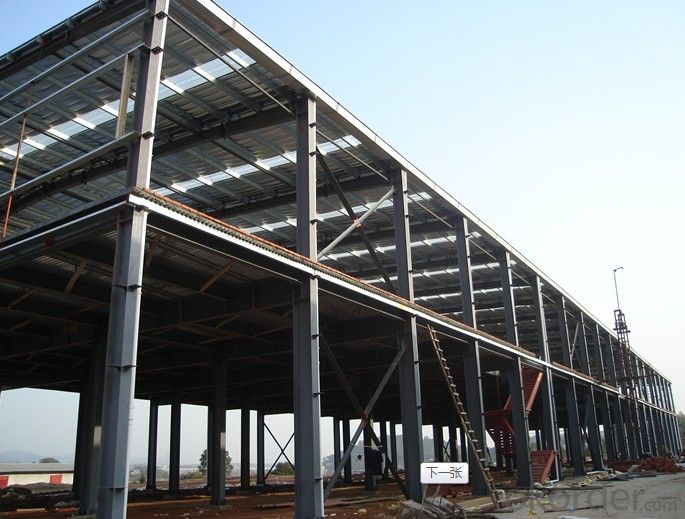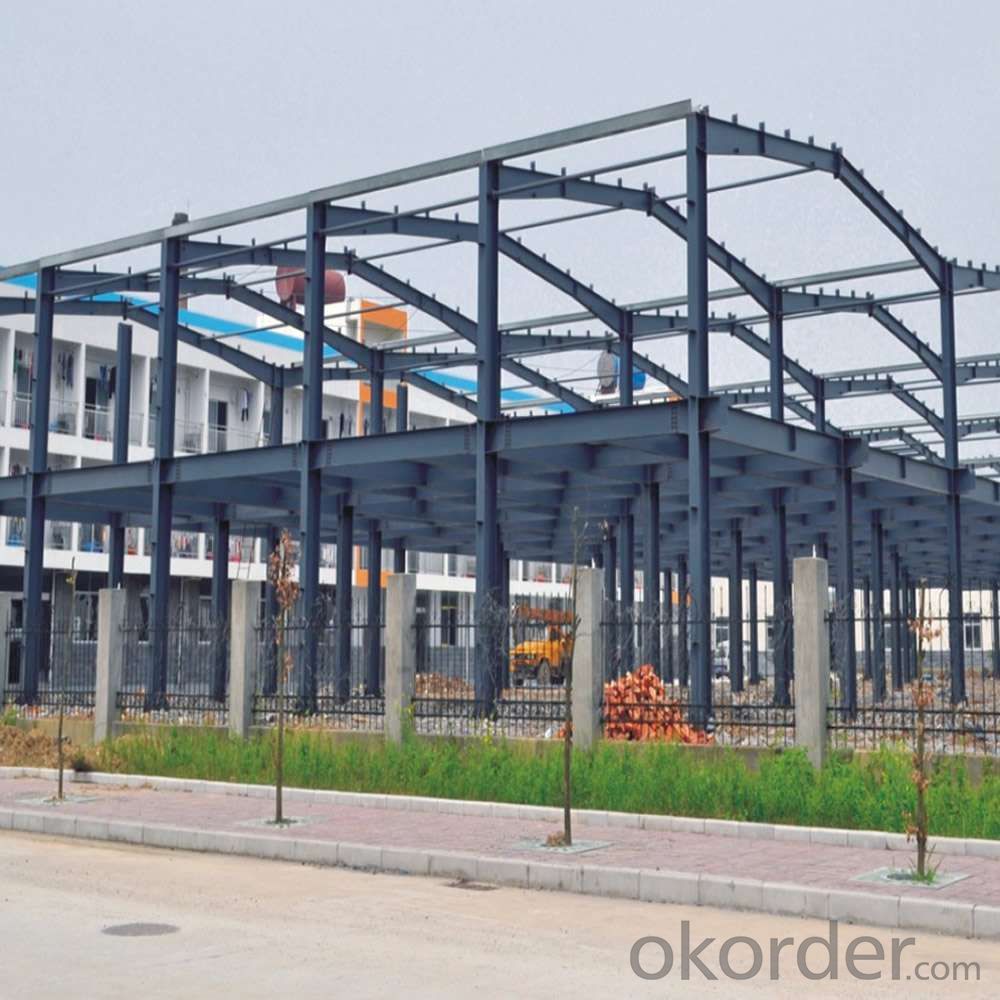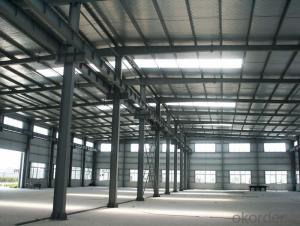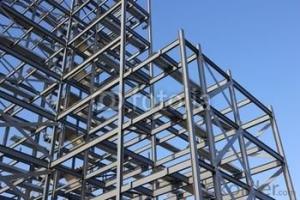High Quality Steel Structure
- Loading Port:
- Nantong
- Payment Terms:
- TT OR LC
- Min Order Qty:
- -
- Supply Capability:
- 200000 m.t./month
OKorder Service Pledge
OKorder Financial Service
You Might Also Like
Steel Structure Warehouse:
1.The steel structure of the connection method: welding connection
2.Steel structure design common norms are as follows: "Steel Design Code" (GB50017-2003) Cold-formed steel structure technical specifications" (GB50018-2002) "Construction Quality Acceptance of Steel" (GB50205-2001) "Technical Specification for welded steel structure" (JGJ81-2002, J218-2002) "Technical Specification for Steel Structures of Tall Buildings" (JGJ99-98)
3.The characteristics of steel Light weight steel structure Higher reliability of steel work Steel anti-vibration (earthquake), impact and good Steel structure for a higher degree of industrialization Steel can be assembled quickly and accurately Large steel interior space Likely to cause sealing structure Steel corrosive Poor fire-resistant steel Recyclable steel shorter duration
4.Commonly used steel grades and performance of steel Carbon
structural steel: Q195, Q215, Q235, Q255, Q275, etc.
High-strength low-alloy structural steel Quality carbon structural steel and alloy structural steel Special purpose steel Product Feature Carport, House, Office, Shop, Toilet, Villa, Warehouse, Workshop, Plant Other Information
Products have been all over the country more than 20 provinces, municipalities and autonomous regions, and have been exported to Europe, North America, the Middle East, Africa, Asia and other countries and regions, the widespread use
Welcome to our factory, we assure that our products will satisfy your needs with designs, competitive performance price ratio and best services.


- Q:How are steel structures designed to be resistant to chemical corrosion?
- Steel structures are designed to be resistant to chemical corrosion through various measures. One common approach is the use of corrosion-resistant coatings, such as galvanization or epoxy paints, which create a barrier between the steel and corrosive substances. Another method is alloying steel with elements like chromium or nickel, which enhance its corrosion resistance. Additionally, proper design techniques, such as avoiding crevices and ensuring adequate drainage, minimize the exposure of steel to chemicals. Regular inspections and maintenance also play a crucial role in detecting and addressing any signs of corrosion early on.
- Q:Can steel structures be designed to be resistant to corrosion from alkaline substances?
- Indeed, it is possible to design steel structures in a manner that makes them resistant to corrosion caused by alkaline substances. One effective method to prevent corrosion involves the utilization of corrosion-resistant coatings, such as specialized metallic coatings like zinc or aluminum, as well as paints. These coatings act as a protective barrier between the steel surface and the alkaline substances, effectively preventing direct contact and corrosion. Moreover, stainless steel can also be employed as a construction material. Stainless steel possesses chromium, which forms a protective layer on its surface known as a passive film. This passive film serves as a robust barrier against corrosion, even when exposed to alkaline substances. Furthermore, the design of the steel structure itself can significantly contribute to corrosion prevention. Implementing proper drainage systems, preventing water stagnation, and ensuring sufficient ventilation can aid in reducing the steel structure's exposure to alkaline substances. Additionally, paying attention to proper detailing and design considerations, such as avoiding crevices and minimizing points where water can accumulate, can also enhance the steel structure's resistance to corrosion. It is important to note that while these measures can greatly enhance the corrosion resistance of steel structures against alkaline substances, regular maintenance and inspections are still necessary to ensure their long-term durability and performance.
- Q:What are the different types of steel foundation systems used in building structures?
- There are several different types of steel foundation systems that are commonly used in building structures. These systems provide a stable and solid foundation for the building, ensuring its stability and durability. One type of steel foundation system is the deep foundation system, which includes driven piles, drilled shafts, and helical piles. Driven piles are long, slender columns made of steel that are driven into the ground using heavy machinery, providing support to the structure above. Drilled shafts, on the other hand, are large-diameter, deep holes that are bored into the ground and then filled with concrete and reinforcing steel. Helical piles, also known as screw piles, are steel shafts with helical plates that are screwed into the ground, providing resistance against vertical and lateral forces. Another type of steel foundation system is the shallow foundation system, which includes spread footings and mat foundations. Spread footings are large, flat pads of concrete or steel that distribute the weight of the building over a larger area, preventing excessive settlement. Mat foundations, on the other hand, are thick slabs of reinforced concrete that cover the entire footprint of the building, providing support and stability. Steel sheet pile walls are another type of steel foundation system that is often used in building structures. These walls are made up of steel sheets that are driven into the ground to create a barrier against soil and water, providing support to the structure and preventing it from settling or shifting. In addition to these systems, there are also steel caissons, which are large, watertight structures made of steel that are sunk into the ground and then filled with concrete to provide a stable foundation. These caissons are commonly used in areas with unstable soil or high water tables. Overall, the different types of steel foundation systems used in building structures provide various methods of ensuring the stability and durability of the building, taking into account factors such as soil conditions, water levels, and structural requirements.
- Q:How do steel structures resist loads such as gravity, wind, and seismic forces?
- Steel structures resist loads such as gravity, wind, and seismic forces due to the inherent properties of steel. Its high strength-to-weight ratio allows steel structures to efficiently support heavy gravity loads. Additionally, steel's flexibility and ductility enable it to absorb and dissipate energy during wind and seismic events, minimizing damage. The use of bracing systems, bolted connections, and proper design techniques further enhance the structural integrity, ensuring steel structures can withstand these various forces.
- Q:How are steel structures designed for bridges and infrastructure projects?
- Steel structures for bridges and infrastructure projects are designed using a combination of engineering principles, computer-aided design software, and extensive analysis. The design process involves evaluating factors such as load requirements, environmental conditions, and material properties to ensure the structures can withstand anticipated stresses and remain safe and functional. Additionally, considerations such as aesthetics, cost, and construction feasibility are taken into account during the design phase to create efficient and durable steel structures.
- Q:How are steel structures used in renewable energy projects?
- Due to their strength, durability, and versatility, steel structures find extensive usage in renewable energy projects. A key application of steel structures in such projects is seen in the construction of wind turbines. The turbine-supporting tower is commonly made of steel to withstand strong winds and vibrations, while also enabling the design of tall and slender towers that maximize energy capture. In solar energy projects, steel structures are employed for the construction of solar panel mounting systems. These structures offer a stable and secure platform for solar panels, ensuring optimal exposure to sunlight. Steel's high strength-to-weight ratio makes it an ideal material for these structures, facilitating easy installation and maintenance. Hydropower plants also utilize steel structures, particularly in the construction of penstocks. Penstocks are large pipes responsible for transporting water from the reservoir to the turbines. Steel's corrosion resistance, high pressure and temperature tolerance make it a suitable choice for penstock construction. Moreover, biomass and geothermal power plants rely on steel structures too. In biomass plants, steel is used to construct boilers and storage silos required for biomass combustion. In geothermal power plants, steel well casings are employed to extract hot water or steam from the earth's crust. Overall, steel structures play a critical role in renewable energy projects, providing the necessary support, durability, and efficiency required for successful generation of clean and sustainable energy.
- Q:How are steel structures designed for resisting live loads?
- Steel structures are designed to resist live loads by considering the expected forces and movements due to the occupants, equipment, and dynamic loads that are likely to be present during the structure's intended use. This involves careful analysis and calculation of the maximum expected loads and their distribution throughout the structure, ensuring that the steel members and connections are designed to safely carry and transfer these loads without excessive deflection or failure. Additionally, factors such as impact, vibration, and wind-induced movements are considered to ensure the structure's stability and safety under various live load scenarios.
- Q:What are the factors that affect the structural integrity of steel structures?
- The factors that affect the structural integrity of steel structures include the quality and grade of the steel used, the design and construction techniques employed, the level of maintenance and inspection, exposure to environmental conditions such as corrosion, and the loads and stresses placed on the structure during its lifespan.
- Q:How are steel structures designed for corrosion protection in marine environments?
- Steel structures designed for corrosion protection in marine environments are typically built with specific measures and materials to ensure their longevity and durability. These measures include the use of corrosion-resistant alloys, protective coatings, and cathodic protection systems. One common approach is to use stainless steel or other corrosion-resistant alloys for the construction of marine structures. These alloys contain elements such as chromium, nickel, and molybdenum, which provide enhanced resistance to corrosion caused by the saltwater and humid environment. By using these alloys, the structures can withstand the corrosive effects of the marine environment and maintain their structural integrity for extended periods. Another method of corrosion protection is the application of protective coatings. These coatings act as a barrier between the steel structure and the surrounding environment, preventing direct contact with corrosive elements. Common coatings used in marine environments include epoxy, polyurethane, and zinc-rich paints. These coatings are specifically formulated to resist the harsh conditions found in marine environments, including high salinity, humidity, and exposure to sunlight. Cathodic protection systems are also employed to protect steel structures in marine environments. These systems work by creating an electrical circuit that redirects the flow of electrons from the steel structure to a sacrificial anode made of a more easily corroded metal, such as zinc or aluminum. By sacrificing the anode, the steel structure is protected from corrosion as the anode corrodes instead. This method is particularly effective in areas where the protective coating may be damaged or insufficient. In addition to specific design measures, regular maintenance and inspections are crucial for ensuring the ongoing corrosion protection of steel structures in marine environments. This includes periodic cleaning, repair or replacement of damaged coatings, and monitoring the effectiveness of cathodic protection systems. By implementing these measures, steel structures can be designed to withstand the corrosive effects of marine environments, ensuring their longevity and safety.
- Q:How are steel structures designed to resist fire?
- Steel structures are designed to resist fire by incorporating various fire-resistant measures. These may include using fire-resistant coatings or intumescent paints to protect the steel from high temperatures. Additionally, structural elements are often designed with fireproof insulation or fire barriers to prevent the spread of flames. Fire-resistant materials, such as fire-rated glass and fire doors, are also used in steel structures to enhance their fire resistance. The design of steel structures also takes into consideration factors such as fire compartmentation and the use of fire suppression systems to minimize the impact of fire on the overall structure.
1. Manufacturer Overview |
|
|---|---|
| Location | |
| Year Established | |
| Annual Output Value | |
| Main Markets | |
| Company Certifications | |
2. Manufacturer Certificates |
|
|---|---|
| a) Certification Name | |
| Range | |
| Reference | |
| Validity Period | |
3. Manufacturer Capability |
|
|---|---|
| a)Trade Capacity | |
| Nearest Port | |
| Export Percentage | |
| No.of Employees in Trade Department | |
| Language Spoken: | |
| b)Factory Information | |
| Factory Size: | |
| No. of Production Lines | |
| Contract Manufacturing | |
| Product Price Range | |
Send your message to us
High Quality Steel Structure
- Loading Port:
- Nantong
- Payment Terms:
- TT OR LC
- Min Order Qty:
- -
- Supply Capability:
- 200000 m.t./month
OKorder Service Pledge
OKorder Financial Service
Similar products
New products
Hot products
Related keywords

























